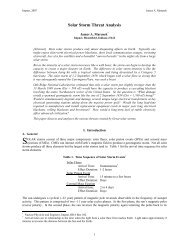THE COSMIC CLOCK, THE CYCLE OF TERRESTRIAL ... - Impact
THE COSMIC CLOCK, THE CYCLE OF TERRESTRIAL ... - Impact
THE COSMIC CLOCK, THE CYCLE OF TERRESTRIAL ... - Impact
You also want an ePaper? Increase the reach of your titles
YUMPU automatically turns print PDFs into web optimized ePapers that Google loves.
2 nd International Conference on Global Warming and the Next Ice Age (2006) TP-10<br />
Ions created by cosmic rays rapidly interact with molecules in the atmosphere and are converted to complex<br />
cluster ions [Hoppel et al., 1986; Gringel et al., 1986]. These cluster ions may grow by ion-to-ion recombination or<br />
ion-aerosol attachment producing cloud condensation nuclei (CCN) at typical atmospheric super saturations of a few<br />
percent [Viggiano and Arnold, 1995; Yu and Turco, 2001]. The droplet distribution of a cloud will then depend on<br />
the number of aerosols activated as CCN and the level of super saturation [Marsh and Svensmark, 2000].<br />
Experiments with charged raindrops have shown that they are 10-100 times more efficient in capturing aerosols than<br />
uncharged drops [Barlow and Latham, 1983]. Increases in CCN concentration also inhibit rainfall and contribute to<br />
increased cloud lifetime [Tinsley and Yu, 2004].<br />
A<br />
III. Seawater as an Ionizing Agent<br />
s waves break in the ocean, a great number of bubbles are formed underwater. These are referred to as the<br />
alpha plume. The bubbles percolate up to the surface forming oceanic white caps and sea foam. One of the<br />
properties of ocean seawater is its high surface tension. As air bubbles burst, seawaters high surface tension causes<br />
the surrounding water to snap back into the depression left by the bubble. As a result, small droplets of seawater are<br />
injected into the atmosphere. The rate ocean salt water aerosols (henceforth referred to as marine aerosols) are<br />
generated above the surface of the ocean is controlled by the wind speed [Monahan et al. 1983]. Wind speeds<br />
greater than 9 m/s, which could be viewed as a minimum threshold, produce great number of spume droplets as the<br />
wave crests are torn apart by the wind. O’Dowd and Smith [1993] have observed sea salt CCN concentrations up to<br />
100 per cc at wind speeds of 20 m/s. Monahan and O’Muircheartaigh [1986] estimated the flux of marine aerosols<br />
varies as the cube of wind speed. Hurricanes can generate great surface wind speeds (exceeding 80 m/s) and loft<br />
these marine aerosols to very high altitudes in convection updrafts. Marine aerosols can be an important source of<br />
cloud condensation nuclei. In addition, the salts in the marine aerosols have the effect of making the water<br />
molecules cluster, become more ordered, thus harder to pull apart and evaporate.<br />
Marine aerosols can be raised from the surface of the ocean to great heights by strong updrafts. In September<br />
1997, hurricane Nora traveled up the Baja Peninsula and fell apart leaving behind a cirrus cloud blow off. This gave<br />
a team of scientist a unique opportunity to study in fine detail, the unusual cirrus event using the Facility for<br />
Atmospheric Remote Sensing (FARS) and the research aircraft and ground based sensors at the Cloud and Radiation<br />
Testbed (CART). From the study Sassen et al. [2003] concluded the mode of cirrus particle nucleation involved the<br />
lofting of sea salt nuclei in strong updrafts into the upper troposphere. This process produced a reservoir of haze<br />
particles evolving into halide-salt-contaminated ice crystals.<br />
Seawater is an effective ion transport carrier with a specific electrolytic conductivity of 53 mS/cm at 25 o C. For<br />
example, seawater is used as an electrolyte in magnesium water-activated batteries. This type of reserve battery was<br />
developed in the 1940’s to meet the emerging military needs for high energy density batteries for applications in<br />
electric torpedoes, sonobuoys, weather balloons, air-sea rescue equipment, pyrotechnic devices, marine markers and<br />
emergency lighting. Seawater reserve batteries have been built that produce up to 460 kW of power [Koontz and<br />
Lucero, 2002].<br />
Marine aerosols have natural properties<br />
that make them very efficient at capturing<br />
nuclear particles within the GCR particle<br />
cascade, thus localizing the ionization site.<br />
Heavy nuclear particles (protons & neutrons)<br />
easily cut deep through the atmosphere<br />
dissipating their energy within a very long<br />
particle shower where the charge quickly<br />
bleeds off and dissipates into the atmosphere.<br />
Water is a natural shield to nuclear particle<br />
radiation. When high-energy nuclear particles<br />
encounter water, they will dissipate the bulk of<br />
their ionization energy at a relatively thin<br />
penetration depth (referred to as Bragg peak).<br />
Refer to Figure 2. At the Bragg peak, the<br />
interaction time becomes larger and the value<br />
of the energy transfer is at its maximum<br />
Figure 2 defines protons (the main component of GCRs), heavy<br />
ions (such as carbon ions) and photons (such as X-Rays) interact<br />
passing through a column of water. The heavy charged particles<br />
(protons & ions) are able to cut easily through objects and<br />
dissipate significant energy at a penetrated depth (referred to as<br />
Bragg peak). [Weber, 1996]<br />
[Weber, 1996]. Fast nuclear particles must be slowed before they are captured. Light nuclei, such as hydrogen<br />
(contained in water), are efficient at slowing down these particles through elastic scattering. Other atoms (boron,<br />
2




